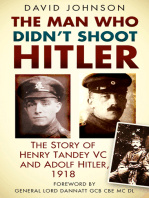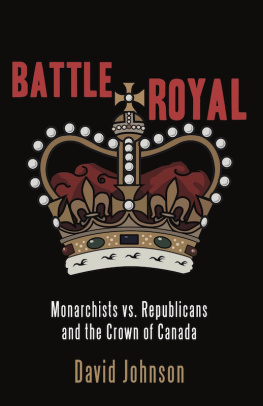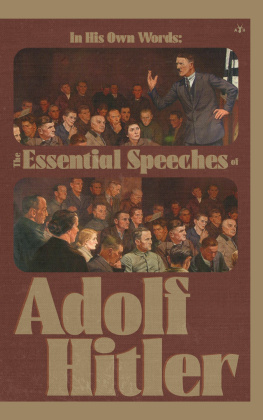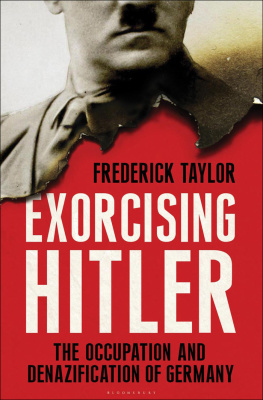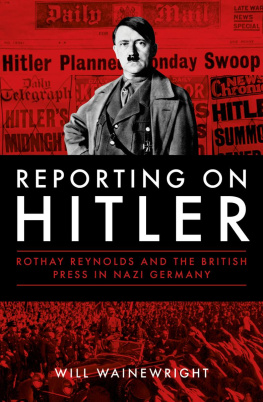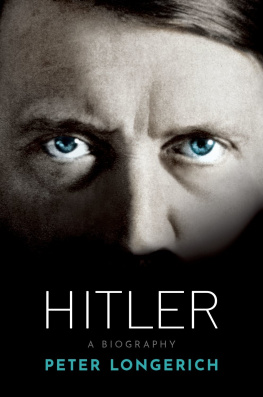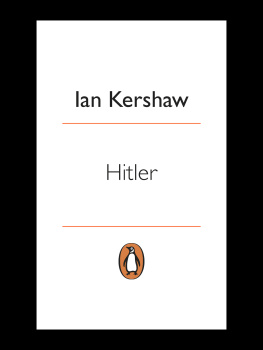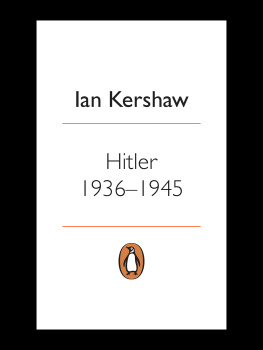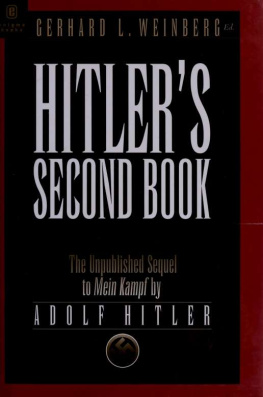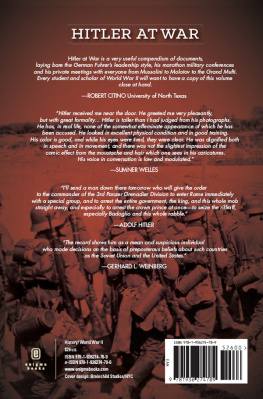David Johnson - The Man Who Didn?t Shoot Hitler: The Story of Henry Tandey VC and Adolf Hitler, 1918
Here you can read online David Johnson - The Man Who Didn?t Shoot Hitler: The Story of Henry Tandey VC and Adolf Hitler, 1918 full text of the book (entire story) in english for free. Download pdf and epub, get meaning, cover and reviews about this ebook. genre: Non-fiction. Description of the work, (preface) as well as reviews are available. Best literature library LitArk.com created for fans of good reading and offers a wide selection of genres:
Romance novel
Science fiction
Adventure
Detective
Science
History
Home and family
Prose
Art
Politics
Computer
Non-fiction
Religion
Business
Children
Humor
Choose a favorite category and find really read worthwhile books. Enjoy immersion in the world of imagination, feel the emotions of the characters or learn something new for yourself, make an fascinating discovery.
- Book:The Man Who Didn?t Shoot Hitler: The Story of Henry Tandey VC and Adolf Hitler, 1918
- Author:
- Genre:
- Rating:5 / 5
- Favourites:Add to favourites
- Your mark:
- 100
- 1
- 2
- 3
- 4
- 5
The Man Who Didn?t Shoot Hitler: The Story of Henry Tandey VC and Adolf Hitler, 1918: summary, description and annotation
We offer to read an annotation, description, summary or preface (depends on what the author of the book "The Man Who Didn?t Shoot Hitler: The Story of Henry Tandey VC and Adolf Hitler, 1918" wrote himself). If you haven't found the necessary information about the book — write in the comments, we will try to find it.
David Johnson: author's other books
Who wrote The Man Who Didn?t Shoot Hitler: The Story of Henry Tandey VC and Adolf Hitler, 1918? Find out the surname, the name of the author of the book and a list of all author's works by series.
The Man Who Didn?t Shoot Hitler: The Story of Henry Tandey VC and Adolf Hitler, 1918 — read online for free the complete book (whole text) full work
Below is the text of the book, divided by pages. System saving the place of the last page read, allows you to conveniently read the book "The Man Who Didn?t Shoot Hitler: The Story of Henry Tandey VC and Adolf Hitler, 1918" online for free, without having to search again every time where you left off. Put a bookmark, and you can go to the page where you finished reading at any time.
Font size:
Interval:
Bookmark:

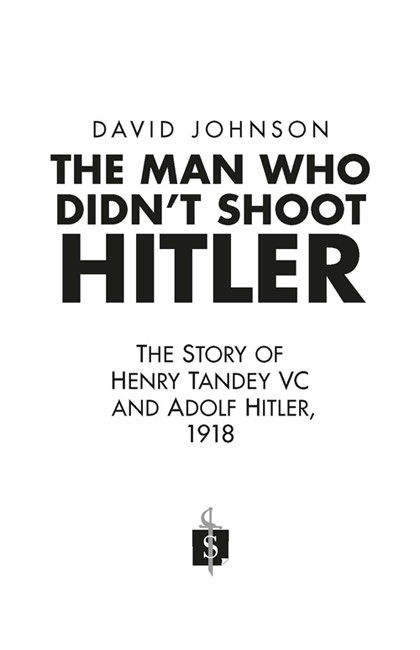
To Val,
and all our family.
Throughout my career in the Green Howards, Private Henry Tandey was always talked of in hushed tones. We all knew that he was the most highly decorated private soldier in the British Army in the First World War, but as good Green Howards we chose to ignore the fact that his principal decorations had been earned while he was serving with the Duke of Wellingtons Regiment. A copy of the famous Fortunino Matania painting of Tandey carrying a wounded Green Howard comrade, surrounded by dead and dying men and horses, hung behind my desk while I was the adjutant of the 1st Battalion years later, and this perpetuated the legend about this exceptional man. Myth has it that further up the road, away from the trenches occupied by 2nd Battalion the Green Howards at the Menin Crossroads during the Battle of Ypres in 1914, and running on into the background of the painting was Adolf Hitler behind a machine gun. In that cherished belief, myth and legend reverently came together.
That is why this timely book by David Johnson is so welcome. From painstaking and detailed research, Dr Johnson has managed to winnow fact from fiction and produce the definitive life history of the remarkable British soldier who was Henry Tandey. Quite properly described as an ordinary man who did extraordinary things, he would have rubbished that description simply asserting that he was doing his duty and that if he was extraordinary at all, it was simply that he was extraordinarily lucky. That said, he would probably have used a different adjective to describe his luck, but there is no getting away from the law of averages that to survive the cauldron of the Great War with three gallantry medals, five Mentions in Despatches and three wound stripes was nothing but miraculous of such stuff legends are indeed born.
The fascination with Henry Tandey does not end with his chestful of gallantry medals and his sleeve bereft of NCOs stripes, but takes further turns and twists that David Johnson explores with forensic diligence. The claim that a retired First World War veteran was telephoned at home in 1940 by the then prime minister, Neville Chamberlain, demands explanation. History has teased with whether Henry Tandey did in fact have Adolf Hitler in his rifle sights on 28 September 1918 near the French village of Marcoing. There is no doubt that Henry Tandey was there that day he won the Victoria Cross on that date and in that place. There is no doubt that Hitlers regiment, the 16th Bavarian Infantry Regiment, was in the Marcoing area on that date but was Hitler himself there? Did Neville Chamberlain, on returning from a meeting with Hitler at Berchtesgaden in 1940, telephone Henry Tandey at Hitlers request to pass on the Fhrers best wishes and was Hitler right that Tandey spared his life on 28 September 1918 by not shooting a wounded man? Such is the material with which David Johnson paints his picture of Henry Tandey a picture albeit in a different art form, but one to rival the image of Matanias Menin Crossroads canvas.
Even though Tandey died at the age of 86 in 1977, his story was even then not complete. His medals continued the narrative after his death. Their trail runs from an auction sale in London to a mystery buyer, then to a chance encounter at a dinner party turning into a delightful relationship between the mystery buyer and Tandeys first regiment, the Green Howards, then on to a presentation of the medals in the Tower of London and finally their return to the Green Howards home in Richmond, North Yorkshire. How all these events came about is a fascinating postscript to Tandeys life which David Johnson records with relish.
For todays young Green Howards who study the Matania painting of the Menin Crossroads, or older veterans who admire Tandeys medals in the Harrison Gallery in the Regimental Museum in Richmond, there is one final irony. The debate over whether Private Henry Tandey was a Green Howard or a hero of the Duke of Wellingtons Regiment has rather run its course. Both regiments are now amalgamated and are both part of the Yorkshire Regiment, formed in 2006, so their proud histories today are one. Whether in fact Tandey would have had a strong point of view on regimental preference is now also a moot point, but it is worth recording that he was born in Leamington Spa and died in Coventry so, he was a man of Warwickshire, not a Yorkshireman at all! Does that matter? Not at all, Henry Tandey will always be remembered as the most decorated private soldier of the First World War who, with one squeeze of the trigger, might have prevented the Second World War from starting at all. David Johnsons intriguing account is compelling to the military historian and the general reader alike. I commend it to you.
Richard Dannatt
General the Lord Dannatt GCB CBE MC DL
Chief of the General Staff 20069
Constable HM Tower of London
The First World War has fascinated me since I was a young boy trying to understand what it was like to be there on the Western Front. What it must have felt like in those minutes before the whistles blew and you went over the top into what would have seemed certain death. What was it like to fix bayonets and charge the enemy? Why did they do it time after time? But it was only in 2009 that I was able to do a tour, titled All Quiet on the Western Front, visiting Ypres, Passchendaele, the Messines Ridge, Ploegsteert, Arras, Vimy Ridge and the Somme. Reading about those places is one thing but to actually be there was truly a powerful experience that I would recommend to anyone. Words cannot describe the effect of visiting the military cemeteries with their rows of gravestones stretching off into the distance, or indeed attending the moving ceremony held at the Menin Gate in Ypres every evening.
During the course of the tour I was struck by how many significant figures from the Second World War had served in such close proximity to each other. The list was fascinating as it included Adolf Hitler, Winston Churchill, Douglas MacArthur and Harry Truman. I have many, many books in my study on the First World War which up until then I had read in a very general way without any particular focus or theme, but on my return I decided to study the Great War in terms of where these significant historical figures had served and what they had been involved in.
Deciding to start with Adolf Hitler, on the basis that he had served throughout the war, I read Corporal Hitler and the Great War 19141918 by John F. Williams, and Ian Kershaws book Hitler 18891936 Hubris, together with material from other sources.
Looking at information on the Internet I quite quickly came across the story of Hitlers life being spared by a British soldier at Marcoing in September 1918. That soldier was identified by Adolf Hitler as Private Henry Tandey, who between 25 August and 28 September 1918 was awarded the Military Medal, the Distinguished Conduct Medal and the Victoria Cross, becoming the most decorated private soldier to survive the war. Yet the more I read about Henry Tandey it seemed to me that he was known more for his alleged compassion towards Hitler rather than for his undoubted bravery. To me, this seemed to do him a disservice and so I decided to find out more about him, with the added interest that he was born in Leamington Spa and later lived in Coventry, while I live in Stratford-upon-Avon, so here was a local as well as a national hero.
Piecing together his life has been challenging and the research constantly threw up more questions than answers as I had to deal with, at times, the possible unreliability of memory and the inadequacies of any surviving documentation. Henry Tandey did not leave a diary or letters, or none have survived, from his time on the Western Front, there are very few remaining family members or acquaintances with any direct knowledge of him, and I was dealing largely with events that took place nearly a century ago. Nevertheless, although challenging, it has also been fascinating, as the further I delved into his life I did start to meet people who had met Henry Tandey and his second wife Annie, and I experienced too the excitement of standing in front of artefacts associated with his life and which he himself had held.
Next pageFont size:
Interval:
Bookmark:
Similar books «The Man Who Didn?t Shoot Hitler: The Story of Henry Tandey VC and Adolf Hitler, 1918»
Look at similar books to The Man Who Didn?t Shoot Hitler: The Story of Henry Tandey VC and Adolf Hitler, 1918. We have selected literature similar in name and meaning in the hope of providing readers with more options to find new, interesting, not yet read works.
Discussion, reviews of the book The Man Who Didn?t Shoot Hitler: The Story of Henry Tandey VC and Adolf Hitler, 1918 and just readers' own opinions. Leave your comments, write what you think about the work, its meaning or the main characters. Specify what exactly you liked and what you didn't like, and why you think so.

